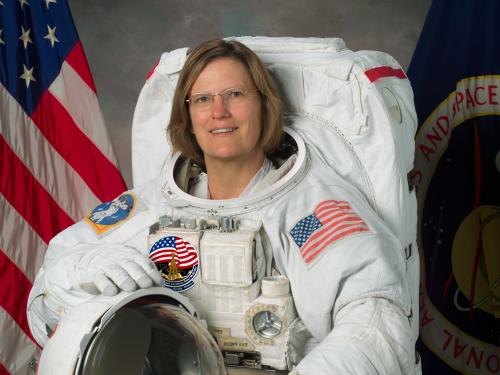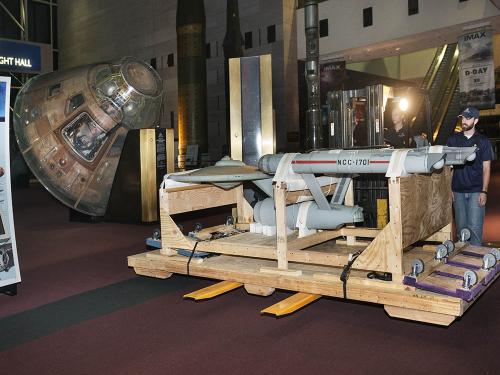
Stories of daring, stories of technological feats, stories of prevailing against the odds ... these are the stories we tell at the National Air and Space Museum. Dive in to the stories below to discover, learn, and be inspired.
Showing 1371 - 1380 of 1761

October 21, 2014
As I was flipping through a set of historical National Air and Space Museum photographs in the Archives a few months ago, one caught my eye—was that a Hecht’s window display? Upon closer examination, it was! But the display from the 1950s wasn’t highlighting the usual dresses, jackets, or shoes. Instead, it featured models from the National Air Museum in celebration of the 30th Anniversary of the Anacostia Naval Air Station (NAS) in Washington, DC.

October 17, 2014
Out Of Many, One by Jorge Rodriguez-Gerada is a large-scale portrait, made of sand and soil, temporarily displayed on the National Mall for the month of October.

October 15, 2014
I suspect that most households have what my parents used to call our “junk drawer,” a place for storing miscellaneous small stuff. Ours was in a handy location, the kitchen. It held scissors, rubber bands, toothpicks, matches, various keys, pins and pens, and spare parts for this and that. Some of the things we used often; most were just there in case a need ever arose. The National Air and Space Museum Archives has such a “drawer”—a whole lot of them, actually—but I wouldn’t consider their contents junk. Officially called the Technical Files, they are located next to the Library and Archives Reading Room on the third floor of the National Air and Space Museum on the National Mall. A treasure trove of materials that don’t belong to specific collections, they serve as a general reference resource for researchers and staff.

October 11, 2014
On October 11, 1984, a female American astronaut stepped outside her spacecraft for the first time. Kathryn D. “Kathy” Sullivan had work to do in the payload bay of the Space Shuttle Challenger, a mobile workplace travelling 17,500 miles per hour about 140 miles above the Earth. Sullivan was one of the six women (in a class of 35) selected in 1978 to be Space Shuttle astronauts, and she was the third woman tapped to fly. An Earth scientist and PhD. geologist/oceanographer, mission specialist Sullivan was a good match for the STS-41G mission, which carried an Earth-observation payload and deployed the Earth Radiation Budget Satellite. She was co-investigator for the Shuttle Imaging Radar (SIR-B) remote sensing experiment and actively involved in research use of the Large Format Camera and other instruments mounted in the payload bay.

October 03, 2014
Shortly before the red and white Cessna 180 was to be suspended at the Udvar-Hazy Center for public display, I called its pilot to give her the news.

September 23, 2014
Noel Hinners served as director of the National Air and Space Museum from 1979 through 1982. He expanded the intellectual scope of the curatorial departments and fostered greater attention to the space sciences, a reflection of his own remarkable career. Born in New York and raised in Chatham, New Jersey, Hinners entered Rutgers University to study agricultural research but became interested in geology.

September 12, 2014

September 12, 2014
On September 11, 2014, the studio model of the Star Trek starship Enterprise, which has been on public display at the Smithsonian's National Air and Space Museum since 1976, was removed for conservation in preparation for its new display location in the Boeing Milestones of Flight Hall, which will open in July 2016. The announcement of the artifact’s inclusion in the transformed Boeing Milestones of Flight Hall was made on April 3, 2014.

September 08, 2014
The world’s first ballistic missile campaign began when the first German V-2 missile successfully launched in combat hit a suburb outside Paris. A second launch later that day hit Chiswick near London. Senior curator Michael Neufeld discusses the V-2 and this campaign.

September 04, 2014
A veteran of four space shuttle flights, Steven Nagel first flew as a mission specialist on Discovery’s fifth trip into space before serving as pilot or commander on his subsequent flights. He was one of only a few astronauts to fly in all three roles.